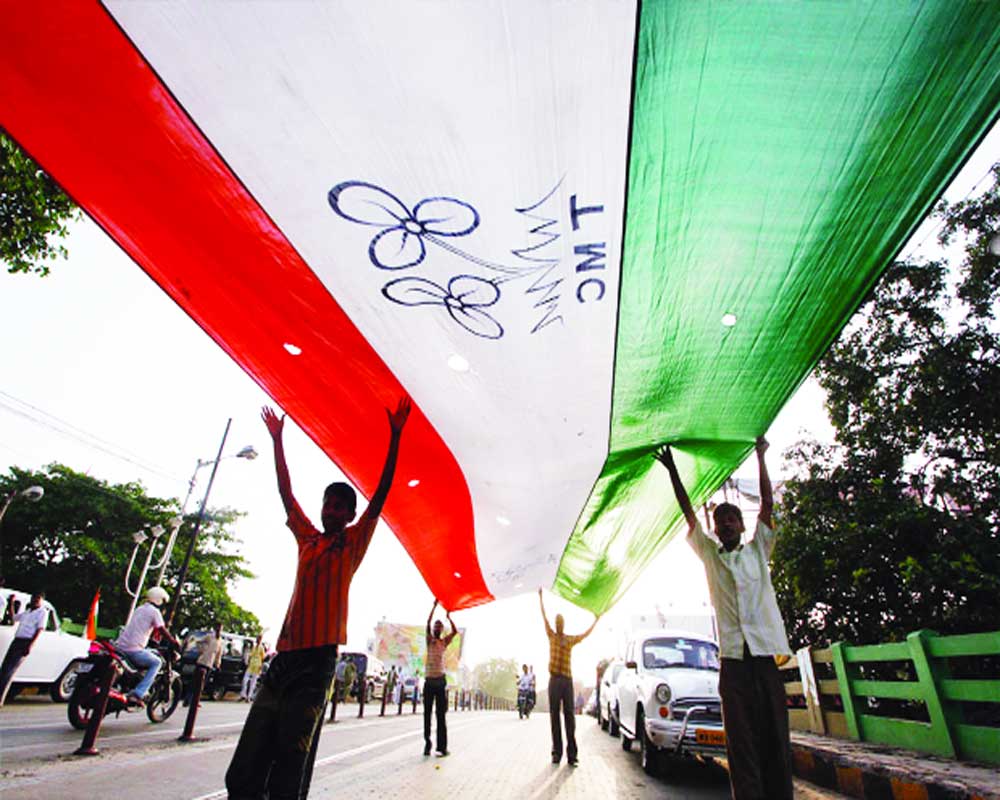After the Lok Sabha debacle, Trinamool gets a booster shot, winning all three bypoll seats in Bengal
Never underestimate the power of Didi,” say people in Bengal whenever Delhi-centric analysts tend to write her political obituary. Some would say that the Trinamool Congress (TMC) chief has a Pied-Piper hold on the Bengali consciousness, a subaltern who rose to be deliverer in a State that swears by female avatars of divinity. What most disregard is that hers is not just a dream story, but one that has been hard-fought, through methods both fair and foul. And in the end, it is her pulsating beat among the masses, her derring-do, her sit-ins bang in the middle of a road, her well-worn Hawai chappals and maternal admonitions that convince them that she is one of their own, their best bet against all kinds of threats and can set Bengal apart from the rest of the country (Bengal still believes it can set India’s agenda). So she took everyone by surprise in 2011, when she uprooted the 34-year-old Left citadel, considering that Buddhadeb Bhattacharya was still popular and had actually started performing. But then opening up Singur for development meant that Mamata hijacked what the Left championed once — siding with displaced farmers. Similarly, six months after being stunned by the BJP ingress in the Lok Sabha elections, she made a whopping comeback, sweeping the Kaliaganj, Kharagpur-Sadar and Karimpur Assembly bypolls. Billed as the litmus test for the BJP’s much-desired domination of Bengal, Didi’s 3-0 tally has shown that she still has it in her to throw rivals off the mattress. The wins in Kaliaganj and Kharagpur-Sadar are significant since they were BJP acquisitions, the party having won the corresponding Lok Sabha segments in Raiganj and Medinipur in May. This is also TMC’s first-ever win in Kaliaganj. Wresting the Kharagpur-Sadar was sweeter as BJP State president Dilip Ghosh was the MLA here before he became MP. Karimpur was hardly a challenge as it was always with the Trinamool.
So Mamata was quick to pin her victories on the BJP’s arrogance in Bengal and completely misreading its people’s minds. What did go wrong with the BJP’s surge in the State and what did Mamata do right this time? The first mistake that everybody probably did was to over-estimate the May verdict as a game-changer. Trinamool, though beaten on the number of seats, didn’t fare too badly on voter percentage compared to other federal parties in Odisha and Tamil Nadu. It increased its vote percentage by almost five per cent to 43.28 per cent. The BJP gains were from the anti-Mamata consolidation and the accretion of the Left and the Congress votes. It is true that a chunk of the Left did merge with the Trinamool after regime change and not much of a challenge was left. But over the years such imports have also been sidelined in the Trinamool scheme of things, which bred discontent. More effective than a revolt, they chose to break the vote pie instead to avenge their denuded status. They simply chose BJP as the enemy’s enemy. Now these groups and voters are also seeing the larger ideological consistencies despite a counter-alignment. Needless to say that the BJP’s trumpeting of a country-wide National Register of Citizens (NRC) has scared a lot of minority voters in Bengal, and not just Muslims, who make up about 27 per cent of the State’s population and include refugees who have been legitimised by successive regimes. Besides, the exclusion of Hindu residents from the Assam NRC riled up Bengali Hindu refugees, too, who have settled in waves since the Partition. BJP candidate from Kaliaganj Kamal Chandra Sarkar went so far as to admit that fears about NRC were among the reasons behind his defeat. Also, the BJP’s polarisation-driven agenda, while picking up traction in the border areas, is yet to fundamentally shake up the eclectic matrix of Bengal. Rather, the May verdict for the BJP was more about seeking change in growth and development paradigms than religion. However, the BJP in Bengal only peddled the latter and appeared revisionist in the process. Mamata, too, meanwhile, learnt her lessons, evening out her minority appeasement with shloka chants and an assertion of her “real” Hindu sentiments. Most importantly — and here poll strategist Prashant Kishor may have had a role — she has stayed away from shooting her mouth off or using agitprops. Instead, she focussed on rebuilding her grassroots connect, a casualty of the extortionary syndicate raj that she had allowed to flourish. Making teas at dhabas and talking to people was perhaps the salve that the voter needed. But till she powers development to the next level of industrialisation — and she has at least steadied the rural economy — she still has a juggernaut trundling her way in 2021.
(Courtesy: The Pioneer)








 OpinionExpress.In
OpinionExpress.In















Comments (0)